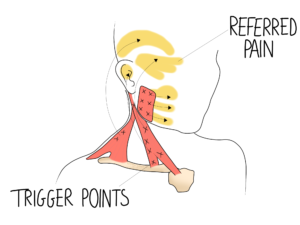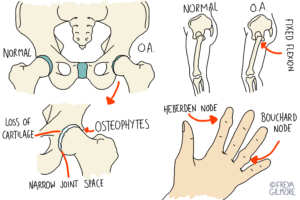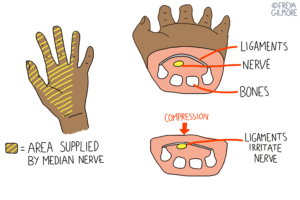When the muscles around the elbow become irritated for too long, they can cause Tennis Elbow. The muscles involved are actually the wrist extensors: touch the painful area and you’ll feel it tense if you bring your wrist back.
The Process of Tennis Elbow
Tennis Elbow is not just a tight or strained muscle. The formal name is lateral epicondylitis. The lateral epicondyle is the part of the bone that the muscle attaches to, and the -itis refers to inflammation. So the process here is actually of inflammation at the point where muscle and bone meet. This makes it a bit more complicated than a simple strain, and helps to explain why it can take so long to shift it. Unlike a strain, pain can be unremitting throughout the day and night. The area may also be surprisingly tender to touch.
The condition develops in response to repeated overloading. Repetitive trauma from overuse of the muscles and tendons causes micro-damage. This in turn leads to local inflammation, that can become chronic if the soft tissues continue to be overworked. The longer the inflammation goes on for, the longer it may take to heal.
The name comes from links with racquet sports, but it can develop in non-athletes too. Repeated gripping of a thin handle, including things like pans or shopping bags, can also lead to its development. Even walking a dog on a lead could provide the necessary repetitive strain. Your osteopath will be able to give you advice for more comfortable ways to do these everyday tasks.
Golfer’s Elbow
The same process can happen to the opposing muscles. These are the wrist flexors, and they attach at the medial epicondyle. This is Golfer’s Elbow, or medial epicondylitis. The symptoms are the same, except they affect the opposite side of the elbow. Pain is made worse with wrist flexion: this could be a feature of exercises beyond golf. As with Tennis Elbow, carrying shopping or something heavy like a full kettle can be a factor in the condition’s development.
Osteopathy for Tennis Elbow Relief
Treatment of Tennis or Golfer’s Elbow is typically conservative. That means rest, stretches, and hands on therapies like osteopathy are recommended.
Like with carpal tunnel syndrome , you might find that your sleeping position aggravates your symptoms. It may be appropriate to offer you a splint for your wrist to stop you flexing or extending it in your sleep. By removing this aggravating factor, you give the body a chance to heal. Combining this with treatment and exercises to keep the muscles relaxed might be all you need to start feeling better. If there is little progress after a few sessions, it may be appropriate to refer you back to your GP. They may offer you painkillers or refer you onto a specialist. However, the NHS Guidelines do not recommend steroid injections for long term relief.
If you feel the symptoms developing, you should make an appointment using the link below. You may find that using a cool compress for 10 minutes helps to take the edge off the symptoms in the early stages. Your osteopath will be able to give you more tailored advice and exercises.
To book an appointment in Midhurst or Petersfield, click here.



